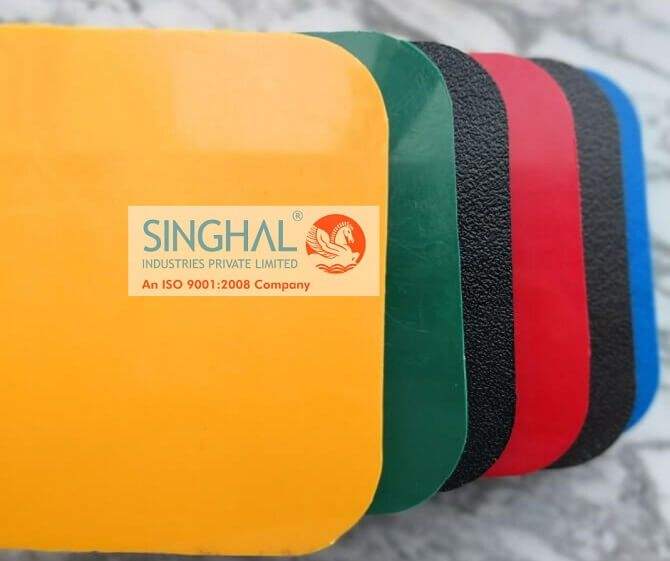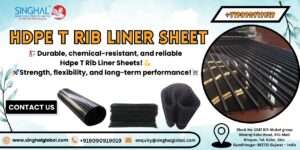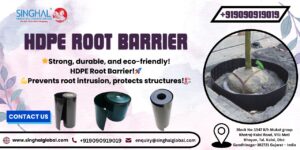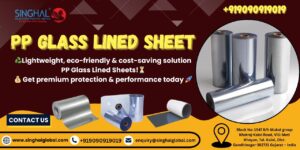HDPE is a short form for High-Density Polyethylene. It is a thermoplastic polymer that is robust, rigid, and thick. It is one of the most flexible plastic polymers now accessible, and it is derived from petroleum. It is particularly well-known for its strong impact resistance, chemical resistance, and low water absorption rates. HDPE sheets are available with firm, smooth surfaces from Singhal Industries Pvt. ltd. It may, therefore, be shaped into precise forms and even utilized in the moulding process or 3D printing. As it is a thermoplastic, it may be easily shaped and sculpted when subjected to elevated heat.
High-Density Polyethylene (HDPE) is notable for its lightweight and elasticity, especially at low temperatures and its high impact resistance. It is not harmed by the products, industrial chemicals, and acids, and it can withstand water temperatures of 100°C.
At 50 degrees celsius, the HDPE sheets undergo oxidation as well as polymer molecular breakdown. Also, at normal temperatures, deterioration occurs in the presence of sunlight. The addition of antioxidants before thermal oxidation can minimize or even prevent it. In terms of voltage transmission, this thermoplastic has a low value. Additionally, it has a high dielectric resistance and power losses (9.15). Moreover, it is reusable and ecologically friendly.
COMMON APPLICATIONS:
Gadgets, cutlery, films, containers, pipes, and processing facilities are all available by HDPE sheets manufacturers. Insulation for wires and cables. But it has several advantages; the key ones that set it apart for most industrial uses are its durability, moisture and chemical resistance, and elasticity. Here’s a more detailed explanation of each of those top advantages.
- First and foremost, there is energy. HDPE has a high potency ratio, which implies it is not easily broken under compression.
- HDPE sheets density also implies that it isn’t susceptible to absorb the substances it carries, which is why it’s so well adapted as a receptacle for fluids and maritime uses. HDPE is, in reality, corrosion-resistant, mildew, dampness, and decay. This enables it extremely resilient in a variety of settings. It is also lengthy, climate, and immune to various basic chemicals, lubricates waxes and acids. Furthermore, HDPE is allowed for use in a range of sectors and situations. The NSF, USDA, and FDA, especially, have all chosen industry-grade HDPE as a secure and clean textile. This implies it can be used in containers or prep surfaces that have actual interactions with snacks and drinks without moisture absorption or seeping chemicals or other elements into the ingredients.
- Lastly, HDPE is simple to shape and mould into certain bottles or forms. Since it has a sharp melting point, HDPE sheets can remain solid until heated to extremely high degrees. Yet, once the material changes its melting temperature, it may be readily formed into almost any required shape by your activities. HDPE is also highly producible in flat sheets, which implies it may be handled utilizing a range of manufacturing techniques, including chopping, wire drawing, drilling, welding, riveting, machining, and cold and hot forming.
Given these features, the pipelines that employ it as the element have a strong benefit over others.
- Easy to set up. For its small weight, the shipping, processing, and changes to ensure are quickened. Furthermore, it does not necessitate the use of a heavy vehicle to transport it.
- They are designed to adjust to changes in orientation and curves, so they do not require connections or extensions. When compared to polyethylene, it is more malleable.
- They can withstand structural load because they pass the majority of the load to the soil surrounding the pipe. This is because of its perforated exterior wall.
- They are impervious to abrasive fluids, blows, and other chemical agents; the usable duration of HDPE pipes is expected to be 50 years.
- They are not utilized together since the welding is done by thermo fusion welding, ensuring the installation’s entire security.
- They assist the liquid flow to other substances’ pipelines due to their flat inner portion. Furthermore, they do not accumulate sediments or incrustations within them.
HDPE differs from normal density polyethylene because it has a larger molecular weight. It can be manufactured by HDPE sheets manufacturers using the Ziegler process, the Phillips technique, or the ‘gas phase’ strategy. In comparison to low-density polyethylene, it is tougher, tougher, denser, and less flexible.
For more details on HDPE Plastic Sheets Features, Applications, Advantages, Specifications refer – http://singhalglobal.com/products/hdpe-sheets-high-density-polyethylene-sheet









